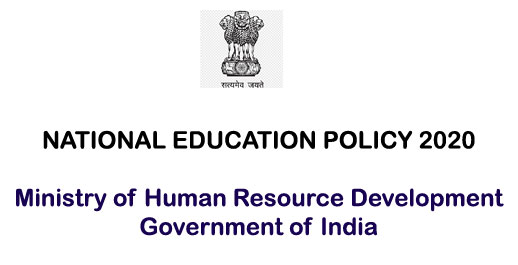By Neelapu Shanti
Education is a building block for a cohesive society of a country. The introduction of New Education Policy sets aspirations for a progressive India towards a progressive direction. The National Education Policy (NEP) aims to bring dynamical changes for upheaving the education structure and improving the quality at all levels to compete on the global platform. The policy aims to universalize the pre-primary education by 2025 and provide foundational literacy/numeracy for all by 2025. It proposes a new curricular and pedagogical structure, with 5+3+3+4 design covering the children in the age group 3-18 years.
To strengthen the higher education modalities NEP’s 2020 proposal to set up the Higher Education Commission of India (HECI) encourages providing necessary support in bringing in the institutional rigour in higher education. HECI is the single body representing higher education excluding legal and medical education. HECI has four independent verticals – National Higher Education Regulatory Council (NHERC) for regulation, General Education Council (GEC) for standard-setting, Higher Education Grants Council (HEGC) for funding, and National Accreditation Council (NAC) for accreditation.
A standardized and relevant institutional structure is of utmost importance to maintain uniformity in education. The idea of developing multi-disciplinary colleges in every district by 2030 will be creating levers for an inclusive education system. The multidisciplinary aspects of learning will enhance student’s ability and develop skills that will help in their career growth.
Right to Education Act of (RTE) of 2009 has been the most important catalyst to transform the demographical dividend by providing free and compulsory education to all children within the age group of 6-14. This act has brought surging enrollment in schools. Higher education beams on the sustainable growth of the nation. The higher education structure comprises of under-graduate, post-graduate and pre-doctoral and post-doctoral programs. India aimed to create the largest working-age population by 2030.
The higher education system in India is faced with the problems of poor quality of curriculum, instruction, teaching module and research. India’s Gross Enrolment Ratio (GER) in higher education is not marked at the average global standards. Higher education institutions will be restructured into three types: (i) research universities focusing equally on research and teaching; (ii) teaching universities focusing primarily on teaching; and (iii) colleges focusing only on teaching at undergraduate levels. All such institutions will gradually move towards full autonomy – academic, administrative, and financial.
Promoting Interdisciplinary Structure through Liberal Arts in Higher Education
The Ministry of Education, Government of India at present has set to achieve its Gross Enrollment Ratio (GRE) of 30% by 2020 and 32% by 2022 for higher education. India’s overarching goals primarily focuses on to scale-up the higher education strata in developing human resource capacities and strategic development investment. India has one of the largest networks of higher education institutions in the world. However, there is still a lot of potential for further development in the education system.
The inter-disciplinary approach has been the most cognitive way to understand the critical issues and logically addressing them this in turn will help to enhance to develop knowledge insights, problem-solving skills, self-confidence, and self-efficacy. We can say inter-disciplinary in higher education is often associated with the liberal education tradition which is related to the cultivation of certain values, knowledge and ideas, and maintaining the academic standard.
Ancient India- Liberal Arts Education
The concept of liberal arts education in India existed for 2000 years. The institutional framework is best known by Nalanda and Takshashila learning centres which were established in the fifth century AD. India’s enriching education is rooted throughout history which is preferred as one of the education destinations in the world. India is focused on a bright and positive future today in talking about education which is the key enabler for development in the world.
It is an important element in bringing dimensional improvement in the economic and social sphere through a balanced and integrated approach. As Nelson Mandela quotes “Education is the best weapon you can use to change the world”. The idea of liberal arts education enables one to contemplate the complexities and constraints that exist in day to day life. As globalization is taking its sphere with challenging situations like climate change, economic, political, security issues and so hence and so forth, countries across the globe are experiencing ballooning problems to tackle. Liberal arts education has pioneering dynamics to develop ideas through critical thinking, analyses and developing multiple perspectives to fulfil the gap of contemporary values and practices.
Traditionally India has followed the liberal arts education for decades which is reflected through the glorious history of education. Imparting of education was based on listening and concentrated contemplation. Understanding the recent trend of our education system, it is high time to realize our requirements to become potential power in learning and knowledge which have been fading away. With time, liberal art education has started to lose its momentum due to India’s colonial history. The education reforms need to be revived especially in imparting the liberal arts domain.
The Nalanda and Takshashila University were the great seats of learning of ancient India. The education system was based on experiential learning, acquired as the students stay in gurukuls with the teacher. In those days, basic education primarily focused on the practical aspects to conduct an active and day-to-day life which instilled consciousness of nation-building, participation in debates and conversations and to discover new things with brainstorming ideas. The concept of learning was based on the practical training and realities of life which was considered the essence of understanding to solve different critical issues to deal in life. Ancient India’s education system witnessed a spectacular and magnificent time that added valuable treasure to society. Liberal arts education is the most effective tool that strengthens the capacities and seeks to empower the students to become proactive contributors to a more peaceful, tolerant, and inclusive and secure world. Exclusively critical thinking and analyses help to seek the noble goals to serve society, humankind and a country as a whole.
